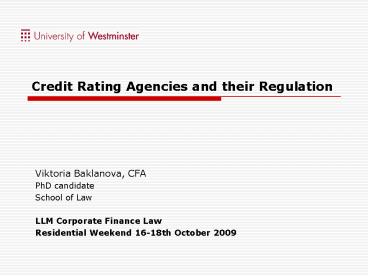Credit Rating Agencies and their Regulation - PowerPoint PPT Presentation
1 / 14
Title:
Credit Rating Agencies and their Regulation
Description:
1860 Henry Varnum Poor's History of Railroads and Canals in the United States, ... DBRS, Egan-Jones Rating Company, Fitch, Japan Credit Rating Agency, Moody's ... – PowerPoint PPT presentation
Number of Views:1165
Avg rating:3.0/5.0
Title: Credit Rating Agencies and their Regulation
1
Credit Rating Agencies and their Regulation
- Viktoria Baklanova, CFA
- PhD candidate
- School of Law
- LLM Corporate Finance Law
- Residential Weekend 16-18th October 2009
2
- Agenda
- History
- Mission
- Rating scale
- Rating types and rating process
- CRA regulation in the U.S.
- CRA regulation outside of the U.S.
- Future of CRAs
3
- History
- 1860 Henry Varnum Poor's History of Railroads
and Canals in the United States, a precursor of
modern stock reporting and analysis - 1900 John Moody Company published Moody's
Manual of Industrial and Miscellaneous
Securities - 1906 Luther Lee Blake formed Standard
Statistics Bureau - 1909 John Moodys started using letter symbols
to express his conclusions - 1913 John Knowles Fitch registered Fitch
Publishing Company, which published Fitch Bond
Book ? Fitch Stock and Bond Manual - 1914 Moody's Investors Service incorporated
- 1941 Poor's Publishing and Standard Statistics
merged to form Standard Poor's Corporation - 2008 10 companies are officially recognized as
Nationally Recognized Statistical Rating
Organizations (NRSRO) Realpoint LLC, LACE
Financial Corp, A.M. Best Company, DBRS,
Egan-Jones Rating Company, Fitch, Japan Credit
Rating Agency, Moodys Investors Service, Rating
and Investment Information, Standard Poors
Ratings Services.
4
Mission
- Creation of stable, transparent and integrated
financial markets - Characteristics of Credit
- Ratings
- Independent
- Forward-looking
- Stable
- Easy to understand
- Broad coverage.
5
Rating Scale Investment grade
6
Rating scale Speculative grade
7
Rating types
- International/National AAA, AAA(CHIN)
- Long-term/Short-term
- Fitch F1/F1, F2, F3, B, C, D
- Moodys Prime-1, Prime-2, Prime-3, Non-Prime
(NP) - SP A-1/A-1, A-2, A-3, B (B-1, B-2, B-3), C,
R, SD, D - Credit rating by sector corporate, municipal,
sovereign, structured finance - Non-credit ratings
- Fitch Recovery Rating (RR), Asset Manager
Rating (AM) - Moodys Market Risk Rating (MR), Servicer
Quality Rating (SQ) - SP Fund Volatility Rating (S), Stability Rating
(SR)
8
Credit rating process
9
CRA regulation in the U.S.
- 1909 1975 unregulated.
- 1975 The U.S. SEC started using credit ratings
to determine capital charges for broker-dealers
(Rule 15c3-1 under the Exchange Act). The term
"NRSRO" was used to designate credit rating
agencies whose ratings would be eligible. - 1994 1997 SEC solicited comments the
appropriate role of credit ratings in rules under
the federal securities laws, and the need to
establish formal procedures for recognizing and
monitoring the activities of NRSROs. Comments
received by the Commission led to a rule proposal
in 1997. However, the Commission has not acted
upon that rule proposal. - 2002 the SEC submitted to Congress its Report on
the role of credit rating agencies in the
operation of the securities markets in response
to the the Sarbanes-Oxley Act of 2002.
10
CRA regulation in the U.S. (cont.)
- 2006 Credit Rating Agency Reform Act of 2006
- Formalize NRSRO designation
- Establish NRSRO oversight
- Promote competition
- June 2007 Oversight of Credit Rating Agencies
Registered as Nationally Recognized Statistical
Rating Organizations - Aug 2007 C R E D I T C R I S I S
- June 2008 Proposed Rules for Nationally
Recognized Statistical Rating Organizations - Enhance integrity of rating process
- Structured finance rating symbology
- Feb 2009 Final Rule Amendments to Rules for
Nationally Recognized Statistical Rating
Organizations - Increase transparency of methodologies,
disclosure of rating performance - Manage conflicts of interest
11
CRA regulation outside of the U.S.
- 2003 the International Organization of
Securities Commissions Technical Committee
published a Statement of Principles Regarding the
Activities of Credit Rating Agencies - Improve investor protection
- Improve fairness, efficiency and transparency of
securities markets - Reduce systemic risk
- 2004 IOSCOs The Technical Committee issued a
12-page document Code of Conduct Fundamentals
for Credit Rating Agencies - 2004 the European Parliament identified issues
of concerns - The quality of the ratings
- The agencies' independence and objectivity
- Transparent credit rating methods
- A high degree of concentration in credit rating
activities and its possible anticompetitive
effects - 2006 IOSCO reported back to the EU Parliament no
further regulation is needed.
11
12
CRA regulation outside of the U.S. (cont.)
- May 2008 6-page document Changes to Code of
Conduct for Credit Rating Agencies - Quality and integrity of the rating process
- CRA independence and avoidance of conflicts of
interest - CRA Responsibilities to the Investing Public and
Issuers - Disclosure of the Code of Conduct and
Communications with Market Participants - April 2009 the European Parliament approved a
43-page document an initial proposal of
Regulation of the European Parliament and of the
Council on Credit Rating Agencies - to ensure that credit rating agencies avoid
conflicts of interest in the rating process or at
least manage them adequately - to improve the quality of the methodologies and
the quality of ratings - to increase transparency by setting disclosure
obligations - to ensure an efficient registration and
surveillance framework, avoiding forum shopping
and regulatory arbitrage between EU
jurisdictions.
12
13
Future of CRAs
- Should credit rating agencies be held liable for
the rating performance? - Yes____________
- No____________
Information assymetry
13
14
Contact information
- v.baklanova_at_my.westminster.ac.uk
- Papers
- Regulatory Use of Credit Ratings How It Impacts
the Behavior of Market Constituents - http//papers.ssrn.com/sol3/papers.cfm?abstract_id
1378627 - http//westminster.academia.edu/ViktoriaBaklanova/
Papers
14































